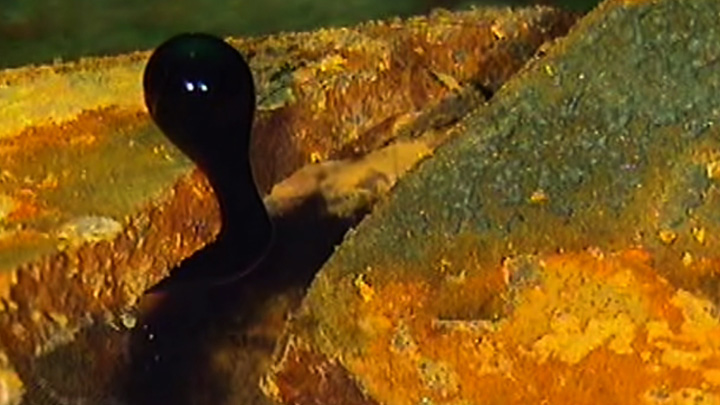More than 30 years after the cargo vessel Manolis L. ran aground and sank off Newfoundland’s scenic Change Islands, the Canadian Coast Guard is recommending the full removal of the remaining oil from the wreck.

The Liberian-flagged vessel was carrying a load of paper when it went down off the Blowhard Rocks in Notre Dame Bay in January 1985 with more than 500 tonnes of fuel and diesel on board, most of which has already leaked.
READ MORE: Oil leaking from shipwreck threatens small Newfoundland community
“There is a risk to the environment, most definitely,” the coast guard’s regional director, Anne Miller, said Friday. “That is why we are recommending the removal of the oil.”
Miller said it is too early to say how much removing the fuel would cost, but she said it was “safe to assume” it would take more than the $6 million allotted to conduct last summer’s assessment.
Miller said it was important to note that the report is positive about what was found by the examination and survey conducted by Resolve Salvage of Fort Lauderdale, Florida.
She said officials have concluded the wreck, which is in about 82 metres of water, is stable, and that apart from the damage sustained in the grounding there is no other significant damage to the hull and no risk of it deteriorating quickly.
The survey indicated there had been only 10 per cent wastage of the steel in the 31 years since the sinking.
READ MORE: Hundreds of shipwrecks pose environmental threat to Canada’s coasts
“There was concern about an imminent release (of oil), and what we have found from this report is that the vessel is stable on the bottom and the structural integrity of the vessel is sound.”
Miller said the survey estimated anywhere from 113 tonnes to 150 tonnes of oil and diesel is still on board. There were more than 500 tonnes on board originally and Miller said it was lost as a result of the accident and through gradual leakage over time.
Change Islands deputy mayor Larry Hurley welcomed the coast guard’s recommendation.
“We’ve been waiting for that kind of news, and fighting for that kind of news,” said Hurley. “It (the oil) definitely needs to be removed.”
However, Hurley, who is also a fisherman, said he hoped news that the hull of the ship is stable isn’t used as an excuse to delay the oil’s removal.
“We know that the ship’s been there for 30 years and if she was sitting on top of the ocean and nobody touched her for 30 years she’d be in hard shape, let alone at the bottom of the ocean. I just hope this isn’t prolonged.”
READ MORE: Coast guard seals oil leaking from 1985 shipwreck off Newfoundland
- Ontario takes action against chemical plant after Aamjiwnaang First Nation residents fell ill
- High benzene levels detected near Ontario First Nation for weeks, residents report sickness
- Enter at your own risk: New home security camera aims paintballs at intruders
- Beijing orders Apple to pull WhatsApp, Threads from its China app store
Hurley noticed a six-inch band of oily tar around his wharf in February 2014. That was one of several earlier sightings of small oil slicks in the area and several reports of oiled eider ducks and other sea birds.
He said as far as he knows there have been no recent reports of oil sightings in the area of his village, which he said is home to about 200 people during the winter months and swells to around 400 or more in the summer when cottagers return.
Miller said there was no timeline yet for the oil salvage work and in the meantime, the coast guard would continue to monitor the wreck by sea and from the air.
READ MORE: Ship that sank in 1985 likely source of small oil slicks off Newfoundland
She said it would be “ambitious” to expect a cleanup by next summer.
Miller also said the removal of the entire vessel wouldn’t be “practical,” because it would be too expensive. In 2013, the coast guard launched a $50 million operation just to remove the fuel seeping from a U.S. army transport ship that sank off B.C.s remote north coast in 1946.
In 2015 the release of federal documents by the area’s Liberal MP, Scott Simms, indicated Ottawa had spent $1.7 million over the previous two years to plug oil leaks coming from the Manolis L.
Money was spent on remote operated vehicles, aerial surveillance and cofferdams to trap oil seeping from cracks in the hull.



Comments